

Nestled in the heart of the captivating landscape of Nagaland, the Phek Waterfall is a gem that represents the untouched natural splendor of the Northeastern region of India. While the state of Nagaland itself has a rich history interwoven with traditions and cultural diversity, the history of tourism, particularly focusing on destinations like the Phek Waterfall, is a relatively recent development.
Historically, Nagaland and its attractions, including Phek Waterfall, were lesser-known to the outside world due to the region's remoteness and special permits required for visitors. Nevertheless, the end of the 20th century and the beginning of the 21st marked a new era where the natural and cultural heritage of Nagaland began to gain attention. Adventurous travelers and nature enthusiasts started venturing into the region to discover its secrets.
The turn of the millennium saw improved infrastructure and initiatives aimed at promoting Nagaland as a unique tourism destination. The Phek district, with the eponymous waterfall as one of its crown jewels, gradually started appearing on the tourist map, especially for those seeking solace in nature away from the bustling city life.
In recent years, eco-tourism and sustainable travel practices have become significant trends affecting destinations like Phek Waterfall. Visitors are encouraged to minimize their environmental footprint and engage in activities that promote conservation and respect for the local environment and community.
Another emerging trend is experiential travel, where tourists are looking for authentic experiences that allow for cultural exchange and personal growth. This ties seamlessly with what Phek district has to offer, as visitors have opportunities to interact with local tribes, understand their way of life, and participate in traditional festivals if their visit coincides with these events.
The Phek Waterfall is an enchanting sight to behold, as it cascades down rocky cliffs surrounded by dense greenery. It stands as a testament to the tranquility and pristine nature that Nagaland is known for. Adding to its allure is the limited commercialization, which ensures that the falls have maintained their natural beauty without being marred by excessive tourist developments.
Visitors to the waterfall can indulge in activities such as trekking, bird watching, and nature photography. The region's biodiversity, including a plethora of unique flora and fauna, makes it an exceptional spot for environmental enthusiasts and researchers alike.
To visit Phek Waterfall, tourists should plan their trip between the months of October and May, which constitute the ideal time to experience the region's beauty comfortably, as this period avoids the heavy monsoon season. Visitors may require Inner Line Permits (ILP), a formality that is easy to complete online or through government offices.
As Nagaland continues to grow as a tourist destination, the importance of places like Phek Waterfall becomes ever more pronounced. With responsible tourism practices and an increased global interest in eco-friendly travel, Phek Waterfall, and Phek district as a whole, is set to be a cherished destination for tourists around the world.